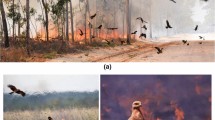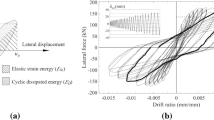Abstract
An efficient reliability-based design optimization method for the support structures of monopile offshore wind turbines is proposed herein. First, parametric finite element analysis (FEA) models of the support structure are established by considering stochastic variables. Subsequently, a surrogate model is constructed using a radial basis function (RBF) neural network to replace the time-consuming FEA. The uncertainties of loads, material properties, key sizes of structural components, and soil properties are considered. The uncertainty of soil properties is characterized by the variabilities of the unit weight, friction angle, and elastic modulus of soil. Structure reliability is determined via Monte Carlo simulation, and five limit states are considered, i.e., structural stresses, tower top displacements, mudline rotation, buckling, and natural frequency. Based on the RBF surrogate model and particle swarm optimization algorithm, an optimal design is established to minimize the volume. Results show that the proposed method can yield an optimal design that satisfies the target reliability and that the constructed RBF surrogate model significantly improves the optimization efficiency. Furthermore, the uncertainty of soil parameters significantly affects the optimization results, and increasing the monopile diameter is a cost-effective approach to cope with the uncertainty of soil parameters.
Similar content being viewed by others
References
Williams R, Zhao F, Lee J. Global Offshore Wind Report 2022. Global Wind Energy Council Technical Report. 2022
Ma H, Chen C. Scour protection assessment of monopile foundation design for offshore wind turbines. Ocean Engineering, 2021, 231: 109083
Hamilton B, Battenberg L, Bielecki M, Bloch C, Decker T, Frantzis L, Paidipati J, Wickless A, Zhao F. Offshore Wind Market and Economic Analysis: Annual Market Assessment. Navigant Consulting Inc. Technical Report. 2013
Gentils T, Wang L, Kolios A. Integrated structural optimisation of offshore wind turbine support structures based on finite element analysis and genetic algorithm. Applied Energy, 2017, 199: 187–204
Tian X, Sun X, Liu G, Deng W, Wang H, Li Z, Li D. Optimization design of the jacket support structure for offshore wind turbine using topology optimization method. Ocean Engineering, 2022, 243: 110084
Kim H G, Kim B J. Design optimization of conical concrete support structure for offshore wind turbine. Energies, 2020, 13(18): 4876
O’Leary K, Pakrashi V, Kelliher D. Optimization of composite material tower for offshore wind turbine structures. Renewable Energy, 2019, 140: 928–942
Ghasemi H, Brighenti R, Zhuang X, Muthu J, Rabczuk T. Optimal fiber content and distribution in fiber-reinforced solids using a reliability and NURBS based sequential optimization approach. Structural and Multidisciplinary Optimization, 2015, 51(1): 99–112
Wang L, Kolios A, Liu X, Venetsanos D, Cai R. Reliability of offshore wind turbine support structures: A state-of-the-art review. Renewable & Sustainable Energy Reviews, 2022, 161: 112250
Ghasemi H, Kerfriden P, Bordas S P A, Muthu J, Zi G, Rabczuk T. Probabilistic multiconstraints optimization of cooling channels in ceramic matrix composites. Composites. Part B, Engineering, 2015, 81: 107–119
Lee Y S, Choi B L, Lee J H, Kim S Y, Han S. Reliability-based design optimization of monopile transition piece for offshore wind turbine system. Renewable Energy, 2014, 71: 729–741
Yang H, Zhu Y, Lu Q, Zhang J. Dynamic reliability based design optimization of the tripod sub-structure of offshore wind turbines. Renewable Energy, 2015, 78: 16–25
Kamel A, Dammak K, Yangui M, Hami A E, Jdidia M B, Hammami L, Haddar M. A Reliability optimization of a coupled soil structure interaction applied to an offshore wind turbine. Applied Ocean Research, 2021, 113: 102641
Phoon K K, Cao Z J, Ji J, Leung Y F, Najjar S, Shuku T, Tang C, Yin Z Y, Ikumasa Y, Ching J Y. Geotechnical uncertainty, modeling, and decision making. Soil and Foundation, 2022, 62(5): 101189
Huang Y, He Z, Yashima A, Chen Z, Li C. Multi-objective optimization design of pile-anchor structures for slopes based on reliability theory considering the spatial variability of soil properties. Computers and Geotechnics, 2022, 147: 104751
Gong W, Huang H, Juang C H, Wang L. Simplified-robust geotechnical design of soldier pile-anchor tieback shoring system for deep excavation. Marine Georesources and Geotechnology, 2017, 35(2): 157–169
Haldar S, Sharma J, Basu D. Probabilistic analysis of monopile-supported offshore wind turbine in clay. Soil Dynamics and Earthquake Engineering, 2018, 105: 171–183
Carswell W, Arwade S R, DeGroot D J, Lackner M A. Soil-structure reliability of offshore wind turbine monopile foundations. Wind Energy, 2015, 18(3): 483–498
Oh K Y, Nam W. A fast Monte-Carlo method to predict failure probability of offshore wind turbine caused by stochastic variations in soil. Ocean Engineering, 2021, 223: 108635
Rabiei M, Choobbasti A J. Innovative piled raft foundations design using artificial neural network. Frontiers of Structural and Civil Engineering, 2020, 14(1): 138–146
Nariman N A, Ramadan A M, Mohammad I I. Application of coupled XFEM-BCQO in the structural optimization of a circular tunnel lining subjected to a ground motion. Frontiers of Structural and Civil Engineering, 2019, 13(6): 1495–1509
Ni P, Li J, Hao H, Zhou H. Reliability based design optimization of bridges considering bridge-vehicle interaction by Kriging surrogate model. Engineering Structures, 2021, 246: 112989
Liu X, Lu M, Chai Y, Tang J, Gao J. A comprehensive framework for HSPF hydrological parameter sensitivity, optimization and uncertainty evaluation based on SVM surrogate model—A case study in Qinglong River watershed, China. Environmental Modelling & Software, 2021, 143: 105126
Ozcanan S, Atahan A O. RBF surrogate model and EN1317 collision safety-based optimization of two guardrails. Structural and Multidisciplinary Optimization, 2019, 60(1): 343–362
Ji Y, Yang Z, Ran J, Li H. Multi-objective parameter optimization of turbine impeller based on RBF neural network and NSGA-II genetic algorithm. Energy Reports, 2021, 7: 584–593
Xu K, Wang G, Zhang L, Wang L, Yun F, Sun W, Wang X, Chen X. Multi-objective optimization of jet pump based on RBF neural network model. Journal of Marine Science and Engineering, 2021, 9(2): 236
Herbert-Acero J F, Probst O, Réthoré P E, Larsen G C, Castillo-Villar K K. A review of methodological approaches for the design and optimization of wind farms. Energies, 2014, 7(11): 6930–7016
Chen J, Yang R, Ma R, Li J. Design optimization of wind turbine tower with lattice-tubular hybrid structure using particle swarm algorithm. Structural Design of Tall and Special Buildings, 2016, 25(15): 743–758
Ma Y, Zhang A, Yang L, Hu C, Bai Y. Investigation on optimization design of offshore wind turbine blades based on particle swarm optimization. Energies, 2019, 12(10): 1972
Jonkman J, Butterfield S, Musial W, Scott G. Definition of a 5-MW Reference Wind Turbine for Offshore System Development. National Renewable Energy Laboratory Technical Report (No. NREL/TP-500-38060). 2009
Carswell W, Arwade S R, Johansson J, DeGroot D J. Influence of foundation damping on offshore wind turbine monopile design loads. Marine Structures, 2022, 83: 103154
Liang F, Yuan Z, Liang X, Zhang H. Seismic response of monopile-supported offshore wind turbines under combined wind, wave and hydrodynamic loads at scoured sites. Computers and Geotechnics, 2022, 144: 104640
IEC 61400-3:. Wind Turbines-Part 3: Design Requirements for Offshore Wind Turbines. Geneva: International Electrotechnical Commission, 2009
Chew K H, Tai K, Ng E Y K, Muskulus M. Analytical gradient-based optimization of offshore wind turbine substructures under fatigue and extreme loads. Marine Structures, 2016, 47: 23–41
Jonkman J M, Buhl J M L. FAST User’s Guide Version 6.0. National Renewable Energy Laboratory Technical Report (No. NREL/EL-500-38230). 2005
Jonkman B J. TurbSim User’s Guide Version 1.50. National Renewable Energy Laboratory Technical Report (No. NREL/TP-500-46198). 2009
DNV-OS-J101: Design of Offshore Wind Turbine Structures. Oslo: Det Norske Veritas, 2014
DNV-RP-C205: Environmental Conditions and Environmental Loads. Oslo: Det Norske Veritas, 2010
Stewart G M, Robertson A, Jonkman J, Lackner M A. The creation of a comprehensive metocean data set for offshore wind turbine simulations. Wind Energy, 2016, 19(6): 1151–1159
Yan Y, Yang Y, Bashir M, Li C, Wang J. Dynamic analysis of 10 MW offshore wind turbines with different support structures subjected to earthquake loadings. Renewable Energy, 2022, 193: 758–777
Cao G, Chen Z, Wang C, Ding X. Dynamic responses of offshore wind turbine considering soil nonlinearity and wind-wave load combinations. Ocean Engineering, 2020, 217: 108155
Chen S, Xing J, Yang L, Zhang H, Luan Y, Chen H, Liu H. Numerical modelling of new flap-gate type breakwater in regular and solitary waves using one-fluid formulation. Ocean Engineering, 2021, 240: 109967
Yan Y, Li C, Li Z. Buckling analysis of a 10 MW offshore wind turbine subjected to wind-wave-earthquake loadings. Ocean Engineering, 2021, 236: 109452
Jung S, Kim S R, Patil A, Hung L C. Effect of monopile foundation modeling on the structural response of a 5-MW offshore wind turbine tower. Ocean Engineering, 2015, 109: 479–488
Kawa M, Baginska I, Wyjadlowski M. Reliability analysis of sheet pile wall in spatially variable soil including CPTu test results. Archives of Civil and Mechanical Engineering, 2019, 19(2): 598–613
Damiani R R, Song H, Robertson A N, Jonkman J M. Assessing the importance of nonlinearities in the development of a substructure model for the wind turbine CAE tool FAST. In: Proceedings of OMAE 2013—32nd International Conference on Ocean, Offshore and Arctic Engineering. New York: American Society of Mechanical Engineers, 2013, V008T09A093
Al-Sanad S, Wang L, Parol J, Kolios A. Reliability-based design optimisation framework for wind turbine towers. Renewable Energy, 2021, 167: 942–953
DNVGL-RP-C202: Buckling Strength of Shells. Oslo: Det Norske Veritas, 2017
NORSOK N-004: Design of Steel Structures. Oslo: Norwegian Technology Standards Institution, 2013
Acknowledgements
This study was supported by the National Natural Science Foundation of China (Grant No. 12072104) and the National Key R&D Program of China (No. 2018YFC0406703).
Author information
Authors and Affiliations
Corresponding author
Ethics declarations
The authors declare that they have no conflict of interest.
About this article
Cite this article
Yu, C., Lv, X., Huang, D. et al. Reliability-based design optimization of offshore wind turbine support structures using RBF surrogate model. Front. Struct. Civ. Eng. 17, 1086–1099 (2023). https://doi.org/10.1007/s11709-023-0976-8
Received:
Accepted:
Published:
Issue Date:
DOI: https://doi.org/10.1007/s11709-023-0976-8




